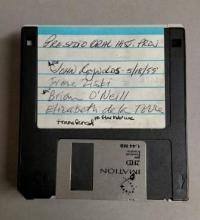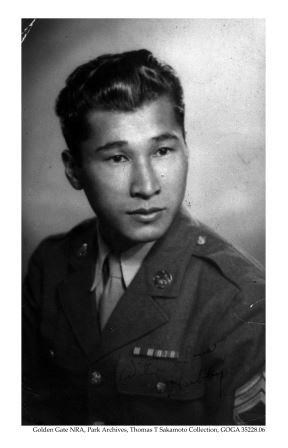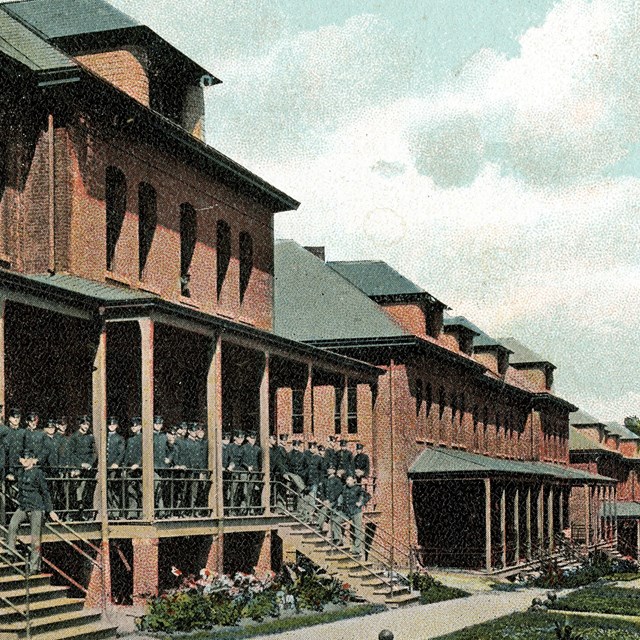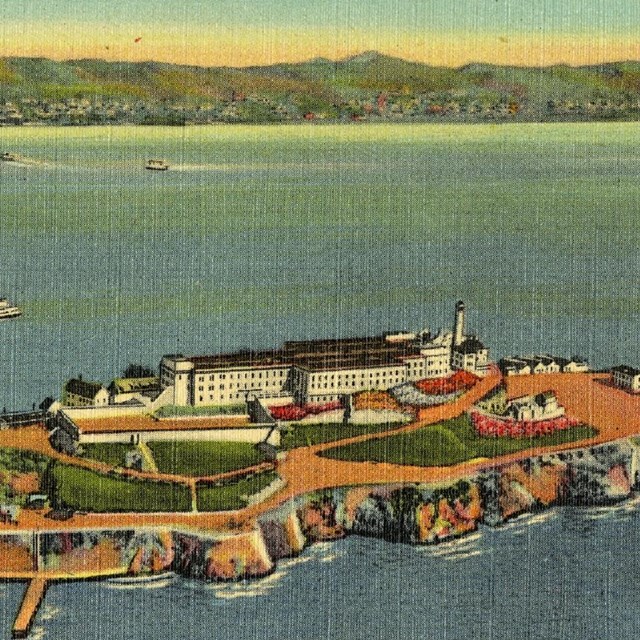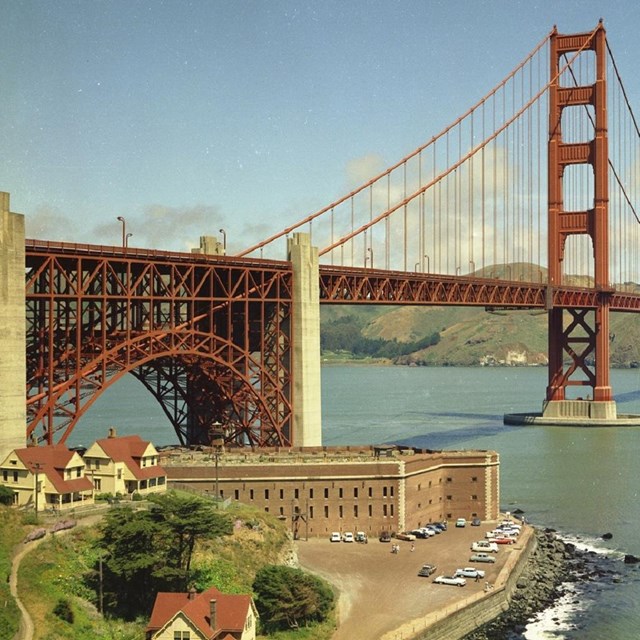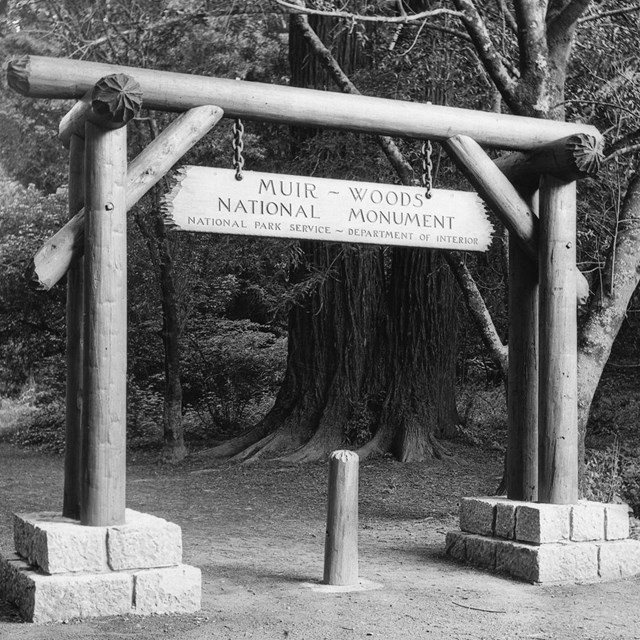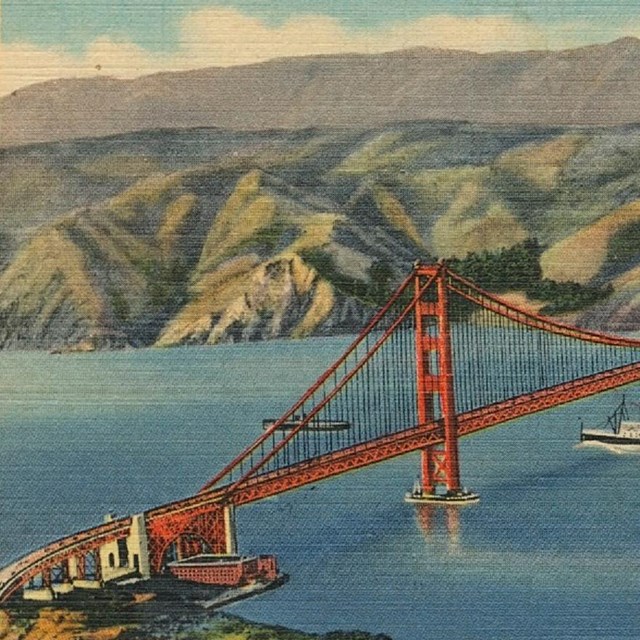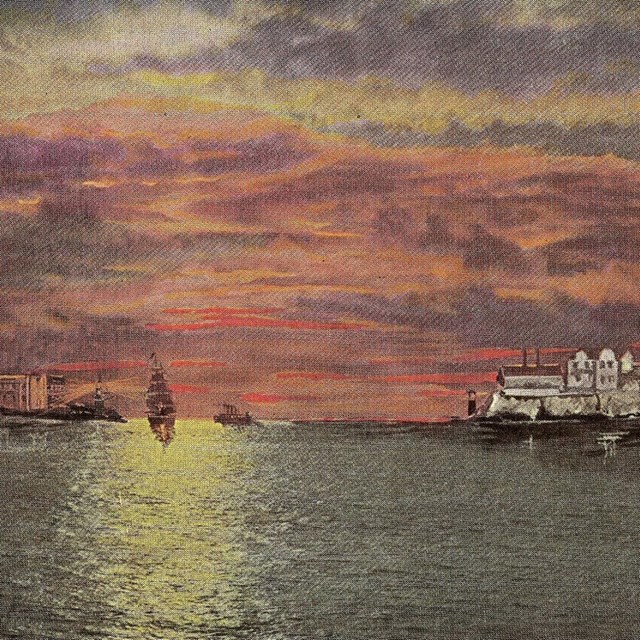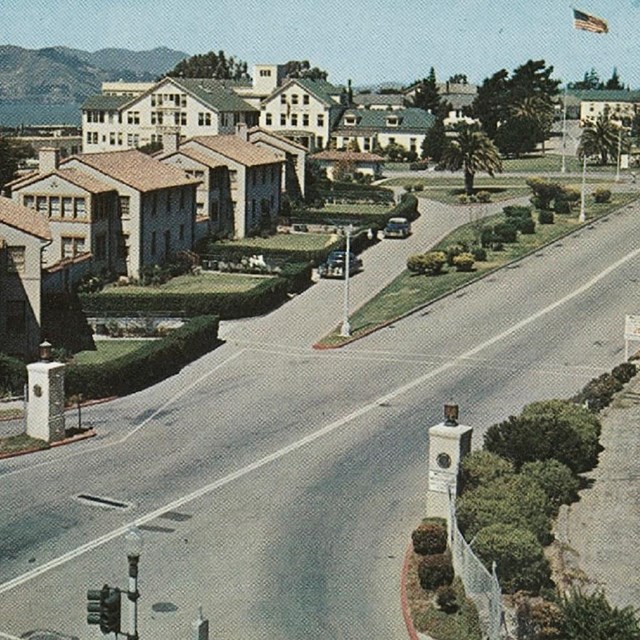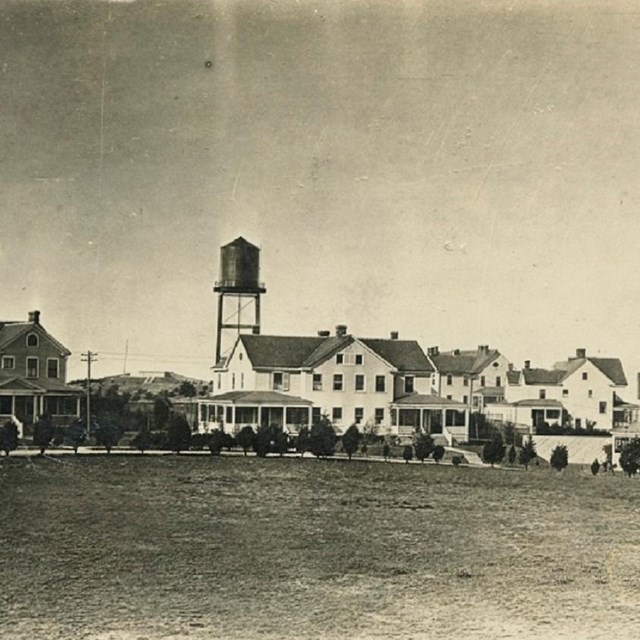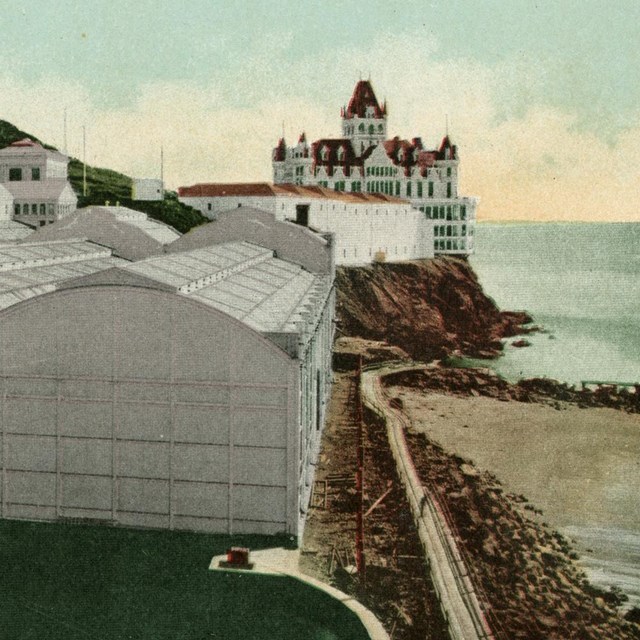[Side A]
Conducted at The Presidio, San Francisco, California with Thomas T. Sakamoto, retired Colonel of the U. S. Army, who was a student in the first class of the Military Intelligence Service Minded School at the Presidio of San Francisco in 1941-42.
Haller: [00:01] Thank you very much for coming here today, Tom. We are making this tape, as you know, for The Presidio Oral History Project, and we plan on using it for research and education about The History of The Presidio. I understand that the National Parks Service has your permission to retain all the literary and property rights to this interview for the purposes that I just mentioned. Is that correct?
Sakamoto: [00:40] That is correct.
Haller: Okay, well why don't we get going into the interview. Perhaps we can start by telling me a little bit about your family background.
Sakamoto: [00:54] Yes. My father and mother, their names are Yasutaro and Fusa Sakamoto came from Kumamoto, Japan in the early 1900s. My father came first via Hawaii, Honolulu, as common laborer and came to San Francisco. My mother was a picture war bride. In those days, that is what they did. And my father ran a boarding house in 5th and Jackson in San Jose. That is where I was born as the second son of 11 children total. In those days, the "Isei" parents more or less lived among themselves as a sharecropper and laborers in Santa Clara Valley. And therefore it necessitated a boarding-house type of thing because most of the Japanese were bachelors at that time. They . . . Community-wise they stuck together, helping each other, and they worked hard day and night to survive because they had the linguistic problem of not communicating and to survive was a major task for them and to raise family. Therefore, you see traces of that era, even today, in that when they came from Japan, they came from certain prefectures throughout Japan, and they formed such a prefectural association, like my folks came from Kumamoto, and even today, the Yonsei [third generation] carry that tradition to remember their roots and conduct memorial service. Therefore when war with Japan arose, the Japanese-Americans were in their teens, and we had no political base. We didn't have congressmen or senators in Congress like we do today. Therefore, they had no political power to fight back when evacuation took place, and that is some of the tragedies of that period for us.
Haller: [3:39] As a youngster, you grew up then during the Depression. Did that effect your work or your school?
Sakamoto: [3:50] Yes, we did a couple of things differently than today. That is to say, we went to public schools and after that school, went to the Japanese language school, and then we worked on the farm, but there…… was the family unit as I recall was closer those days than today because it was a matter of sticking together to survive.
Haller: [4:31] How about .. . You mentioned that you went to Japanese language school after school, so obviously you continued, your family continued to want to stress the Japanese culture?
Sakamoto: [4:45] Yes.The intent of our parents was to send, eventually, the oldest son to Japan for education. Not only that but because our parents were denied the right to become citizens, and even become a naturalized citizen, that their mind-set was always that at that time, to make money, and eventually go back to Japan. Therefore, the Japanese language, the tradition, was very important to the parents, and as the oldest son, I was sent to Japan, Kumamoto, in 1934, and went to Christian Middle School [graduated] in 1938. At that time, the Japanese army was marching into North China, and the political climate and atmosphere of war between Japan and the rest of the world became very intense. I was . . . I studied hard because I was not born and raised in Japan and to compete in Japanese academic environment was pretty difficult. Nevertheless, I took up ROTC in Middle School. In fact, I was, for some reason, I was selected as platoon leader and flag carrier and that type of thing, and when I graduated in 1938, the ROTC Senior Advisor, an regular Army Major of the Japanese Imperial Army came to me and called me into the office and asked . . . stated that they want to give me a probationary officer's rank and ….demanded that I accept it. I . . . At that time, I felt all along that I am American, and I declined that offer, and you must remember that in those days, the war footing in Japan was very intense and to object to something like that was very serious, but I stood my grounds, so he chewed me out royally, that I was a traitor to the country. But since then, I have never deviated from my philosophy and conviction that I am American despite the fact that with Pearl Harbor, my folks were sent to rural Arkansas, and those were the difficult periods for me.
Haller: [7:57] I can well imagine. When you were in Japan, did you get along well with the Japanese fellow students.
Sakamoto: Yes, uh huh, I did . . .
Haller: Did they make you feel different because you were an American?
Sakamoto: [8:12] Well, we were always identified as non-Japanese because we didn't have the mentality of a Japanese born and raised there, but we got along very well. In fact, I did fencing in Japan, and I traveled throughout Japan as a Kendo Fencing Team. In fact, I was given a second rank when I left Japan, but at the same time, the talk among the students then, this was 1937-38, when Japan entered Shanghai, the feeling that one day . . .well war was often jokingly discussed among classmates.
Haller: [8:59] Those who were from the United States. . .
Sakamoto: Yes, that we would be fighting each other some day.
Haller: [9:07] You mentioned . . . you referred to this as a middle school. Was this . . . What age were you then.
Sakamoto: [9:15]I was 16-19. It was a high school then, but they called it middle school. Now here, they call middle school high school, I guess, right?
Haller: [9:29] junior high . . .
Sakamoto: Yes, junior high. . .
Haller: That's what I was trying to clarify.
Sakamoto: It was high school level [a 5 year course].
Haller: [9:43] What did you do when you got back to the United States, and how did you feel?
Sakamoto: [9:44] Well, I came back because my father sent me $100 and a suit, and told me to get back home. So I came back, and you know, it's a big family we had, and I was young, but I wanted to help out. So I went to the Farm Credit Bureau of the State of California. I borrowed $800, $400 in 2 increments. I bought a tractor and started this 43-acre farm in the North of San Jose. Forty-three acres was a big farm, and I worked hard to raise vegetables and an orchard, but the draft . . . When President Roosevelt instituted the lottery system for the draft, where they took the numbers of the candidates for draft from a goldfish bowl, my number came up right away. So as the oldest son, I don't know, I guess I could have gotten out. . . I didn't . . . I was so naïve . . . but I thought I should go. So I was drafted in February 26, 1941.
Haller: [11:11] Where did you go after you got drafted?
Sakamoto: [11:11] Some of the scenes . . . In my talks to people, I always mention that when we were drafted, there were 10 of us [Japanese-Americans]from San Jose, and of course, many years later, today I don't remember the names and of those that I do they are dead, but we . . . in February 1941, we were still at peace with Japan, and we were taken to Santa Clara Train Depot, which no longer exists, but the Japanese community came out with both Japanese and American flags and made speeches and waved, "Bonzai" and that's how we went off to war, I mean, to the Army. And that echo of "Bozsai" stayed with me for a long time. Then I went to Monterey and immediately to Fort Lewis where I received my basic training. And it so happened that in 1941, in the summer of 1941, we were at Hunter-Legitt maneuvers at Paso Robles, and a friendly-looking man in civilian clothes - I don't know how he got my name, but he called me aside to a tent and said, "Private Sakamoto, do you want to go to 'Frisco?" and said, "Can you read this book?" and he pulled out a black textbook. And I read and translated it, and that book later I learned was the textbook that he acquired when he was a language officer in Tokyo some years before 1941.
Haller: [13:20] What was his name?
Sakamoto: [13:20] His name was Rasmussen, and at the time he was a captain, Captain Kai Rasmussen, and even then he has a thick Swedish accent, and I . . . he promised that I could . . . he would promote me to a Commissioned Second Lieutenant in one year if I accepted this secret school that they are going to begin in Presidio. And I thought, "Gee, my option was pretty obvious, because I was a buck private . . ."
Haller: [14:00] What kind of outfit were you in at that time?
Sakamoto: [14:00] I was in the anti-tank battalion of the 3rd Infantry in Fort Lewis, and we were sleeping in pup tents, so it was bad. I said, "Sure, I'll volunteer."
Haller: [14:27] That was the 3rd Infantry Division?
Sakamoto: [14:28] Yes, Division in Fort Lewis. . . Then I reported to the Presidio hangar. It was a dilapidated airplane hangar with cement floor, double-deck bunks, very crude, just the basic furniture, things like that, and we lived, slept, studied in that building. And as I recall, there were 3 classes, A, B, C classes, and because some of us had education in Japan, we were in A class. The teachers that taught us were not strong in Japanese. I guess they were recruited through colleges or wherever, but some of us knew more Japanese than the teachers at that time. But when Pearl Harbor hit, we immediately . . . the whole atmosphere changed. In fact, when Pearl Harbor hit, and a few weeks later with the Seabee destroyed battleship and destroyers coming into Mare Island because they were all shot up, and we knew then that the war in Pearl Harbor was pretty serious.
Haller: [16:05] How did you get to the Presidio at first? Did you travel on your own or with a group of fellow students?
Sakamoto: [16:14] I don't remember. It was so long ago. I was in Hunter Legitt then. I never went back to Fort Lewis, I just went to Presidio.
Haller: [16:27] Do you remember your initial impressions when you got to the base?
Sakamoto: [16:33] Well, it didn't look like a school for one thing, and we didn't know what to expect, but there were 60 of us, 2 Caucasians, and I guess 15 did not graduate, didn't make it, but what I recall is we really studied hard and then on weekends we went out to Chinatown or Japantown until the evacuation took place, and there were not that much…. visual hatred or that type of thing because we wore a uniform, and they did not know us from the Chinese, I guess, but when I was farming the 43 acres as the oldest son, I went to see my landlord in Modesto, he was living there. And on my return trip with my father, we stopped at the gas station and then they were looking at us very peculiarly, and then when I turned the radio on, I realized the war had started, Pearl Harbor . . .That's how I learned of Pearl Harbor attack, at that time.
Haller: [17:53] You must have been on leave then?
Sakamoto: Yes, I had a few days' leave.
Haller: I see. . .
Sakamoto: [18:03] And . . . So, we studied . . . we had . . there was translation [?] military type of language and geography and that type of thing, but the school for us , for me, was not that difficult because we just graduated in 1938 in Japan.
Haller: [18:29] What was the typical routine like per day at the school?
Sakamoto: [18:35] Well, you had your set subjects that were taught, and usually one teacher stayed most of the time in our class, and we took a subject like geography or military terminology, interrogation of prisoners of war, that type of thing, and each day there was examinations, so they kept us alert to what they taught us.
Haller: [19:10] Did you have any physical training or any sort of outside activities when you were . or were the only activities classroom stuff?. .
Sakamoto: [19:18] The only activities were just classroom and maybe the volleyball outside. And we marched to Cooks' and Bakers' School, I think, 3 times a day, you know, to eat. The food wasn't bad.
Haller: [19:25] So you ate at the Cooks' and Bakers' School, but you went back to Building 640 to sleep, is that correct?
Sakamoto: [19:44] To sleep and study.
Haller: [20:00] What kind of facilities were there for them? Do you recall anything like the furniture? Even in the classroom?
Sakamoto: [20:01] Well, we had a crude double bunk setup with one footlocker on a cement floor. I don't recall any closet, and we stood formation within that building periodically for inspection. I never saw General De Witt. I understand he came by but we did see General Wreckerling, he was then a Lieutenant Colonel, I think, and then Rasmussen and Dickey. I think the teachers were very occupied and hurriedly drafting the curriculum, you know, by mimeographing the thing, but we did study hard and . . . but at the same time, on weekends we did we were able to get out and go downtown.
Haller: [21:20] What was it like in Downtown San Francisco in those days?
Sakamoto: [21:27] Well, it was nothing unusual. you know . . I don't . we . .(better get some water? [Because of Haller's coughing]) [Pause]
Haller: [21:38] We were talking about the day-to-day arrangements at the old Crissy Field Hangar. Did the students have to set up their own living arrangements as well, did they have to set up the quarters as well as doing the studying, or did you find things set up for you when you arrived?
Sakamoto: [21:54] Well, we lived in the same building and as a soldier, we were expected to maintain our clothes, uniform, shoe polish, and that type of basic routine. I . . As I recall. . . I don't. . . It was so long ago that I've forgotten many of the details , but discipline-wise it was pretty well run. We cooperated with each other and were all buck privates or PFC's then.
Haller: [22:38] So who did you take your day-to-day orders from?
Sakamoto: [22:42] Basically, there was administrative personnel, I forget his name, was the head of the . . and then of course the major portion of the day was studying, so we saw the one teacher for almost 8 hours. And then those that were weak in language had to study in the toilet because that's where the lights were after lights out at 10 o'clock.
Haller: [23:17] Did you get to see much of the rest of the Post or were your outings pretty much confined to back and forth to the Cooks' and Bakers' School?
Sakamoto: [23:28] I don't recall being restricted, but because the requirements to study and to go 3 times to the Mess Hall back and forth, we did not have much time.
Haller: [23:43] You know you mentioned your occasional, your weekend trips into San Francisco. Do have any good memories about being on leave?
Sakamoto: [23:53] Well, being that age, we did a lot of visiting Japantown, to the bars and things like that and then to Chinatown, a good time, and I don't . . . never thought there were any restrictions at that time except like you read in the papers, about the discrimination and all that and the war hatred, but our individual life was pretty well normal , I thought. We wore a uniform all the time.
Haller: [24:27] I see. Did you feel anything . . . could you notice a change both either on the Post or off the Post after December 7th?
Sakamoto: [24:41] Well . . . a lot of changes in that, I think it was May 1942, when the evacuation started and . . It so happened that when my parents decided to go to Stockton, Delta area, I happened to get a leave or it must have been a weekend, I forgot, but imagine, you got 43 acres of farm planted in vegetables and that kind of crop, and they are leaving in just so many hours, what would you take? You know, that's a big thing, and that was a shocking experience because I was the oldest son, and I felt responsible for their well-being but I was already in uniform, and I thought in those days, you go in one year and you can get out, but it never happened. So those were the trying moments because they went to the Stockton Delta area to escape the curfew, but they had no one there that they knew and they just went there as a transient. When we graduated in May with Pearl Harbor, the class was abbreviated to a 6-month class, and when we graduated, 35 of the Nisei's were sent overseas to Alaska, Guadalcanal, and elsewhere, without any promotion. And many of them . . . the commanders in the field did not know how to use them, nor did they trust them, so some ended up as Jeep drivers, that type of thing, until they captured prisoners of war or documents, and then they started translating. Then they realized that there was another side to the use of Japanese-American linguists in that they could find out what is before them in the battlefield, and then the cry for more linguists ensued, and that is how this school grew. But 9 of us were selected to be enlisted instructors to go to Camp Savage, and I was one of them.
Haller: [27:32] When the school was over, was there any formal graduation ceremony?
Sakamoto: [27:37] Not that I recall. . .Not anything that stands into my mind. I mean, I don't remember what happened. Oh, I do know that I got this certificate here, and I guess I got that after the fact, I don't remember when I got it, but I kept it. But I did . . . When I graduated, I thought we were going to go into the Far East, go to the Far East for combat, so I went to say goodbye to my parents who were living as a transient in Stockton. And that was a most difficult time for my parents because they thought I'd be going overseas.
Haller: [28:27] Were you . . How did you become aware of the evacuation and determine where they fled?
Sakamoto: [28:34] Through newspapers and radio.
Haller: [28:39] And how did you learn about your family's particular situation?
Sakamoto: [28:45] That they had to evacuate?
Haller: And where they were going, yes. .
Sakamoto: [28:52] Well, I went to Camp Savage and I wrote letters, and that's when I learned that they were put on a train and went to Arkansas. I did visit them one time there, . . . but I stayed as an instructor at Camp Savage until 1943, it was August. I guess I was young and very impatient. I wasn't too happy just teaching and correcting the civilian teachers' papers, test papers on Saturday. Being a civil servant, they worked so many hours a day but we were soldiers and worked all the time. So I volunteered for overseas, and I noticed, a sergeant and myself took 60 men to Brisbane, Australia, to MacArthur's Headquarters.
Haller: [30:19] What was it like when you arrived at Brisbane?
Sakamoto: [30:20] There were people there already, but it took us one month to get to Australia because we had to evade the submarine in the Pacific Ocean. . . We left . . . from Angel Island, then we loaded for a base, and I don't recall, then went down along the coast of California, down to South America and then New Zealand, and then Australia. Just about. . . . it took us one month.
Haller: [30:49] I see. Do you remember the name of the ship?
Sakamoto: [30:55] No I don't. (heh). I am very susceptible to seasickness. I slept on deck all the way to . .. but once we got to Australia, they still wanted me to be instructor of the Japanese language because many of the Japanese-Americans there . . . were not fluent in the Japanese language, speaking or writing. So . . .
[Loud background noise] But I asked to be assigned to combat duty, and I did go to two of the campaigns. .. to the Island of Los Negros and Admiralty Islands.
Haller; [31:51] So what outfit were you assigned to?
Sakamoto: [31:53] I was assigned to elements of 1st Cav, 1st Cav Brigade headed by General Chase. He was a Brigadier General. And I . . . You know I went from Brisbane to Finschhafen Island in New Guinea. That's where the elements of the 6th Army was, under General Krueger, and they sent me to a small island, an island called Goodenough, a rendezvous for takeoff to and reconnaissance landing, and I reported to the 1st Cav Headquarters, and I knew no one. And they came from Texas, 1st Cav came from Texas. And they put me on a destroyer, and it took most of the night from that island to the landing place at Admiralty Islands called Los Negros, and I got so seasick that a sailor gave me a bucket to take care of myself. Then we went, after the bombardment by the destroyers, we went on a landing craft, and there we were, went into this harbor at Los Negros. The reason for Los Negros was that it was the only major airport which was used by the Japanese military to intersect the New Guinea Coast and New Britton, and this island had airstrip set in one of the key areas and so to capture that island was strategically very important for General MacArthur. So I went on a small landing craft, and we were machine-gunned as we entered that harbor. And then went into a crude command post area where I stayed close to the General and his two intelligence officers. And it rained, it rained all the time. And when people started bringing these captured documents, the operational military papers, operational orders, and that type of thing, written on rice paper, and when you turn it over, you cannot turn it back, so you got to be very correct in translation. And next to me was the General and his staff, and he had access to 9 destroyers offshore. And the whole island was marked in grid squares, and as I translated, like this captured document that I got that was one of the major key documents which stated that Captain Baba of battalion would advance the next night at such and such hour to decimate the U.S. military that just landed, the General got on the phone, and as I translated, I could hear the shells going over my head from the 5-inch guns of the destroyer. But we. . . At that time, the General said, he couldn't pronounce my name, Sakamoto, so he kept calling me Yokohama, Sargent Yokohama. . (heh, heh) . And he assigned me a bodyguard. He was, I forget his name, he was a New York policeman, a big guy, an Irishman, and he and I dug a foxhole, and you know that the coral was so hard that you couldn't make a dent, but anyway, we dug in about 2', and he and I slept in the same foxhole for 3 days and 3 nights. Because. . . after I translated that document, the war became very, very intense . .
Haller: [36:49] Was this the blank, the attack order that you mentioned to me previously when we were traveling?
Sakamoto: [36:54] Yes, that's right.
Haller: So this document that you translated was in fact the plans of the Japanese military?
Sakamoto: [37:03] Yes, it was the last defense on that Los Negros Island to save the remote airstrip. And then, after 3 days of combat, the sentry sighted movement in the . . . about 30 yards from our CP, and General Chase then
Haller: Yes.
Sakamoto: [37:38] Told me to make them surrender, so I shouted, and I hollered, and I said everything under the sun, but they did not raise a white flag and come forward. Instead, they threw a hand grenade. So they moved forward and the General said, "No, Sargent Yokohama you stay behind," and the others went forward and fired and killed them, and Captain Baba was one of them.
Haller: [38:10] One of them who ?
Sakamoto: [38:14] One of them who was killed. That was bad. 15 dead officers and three sergeants were counted, including Captain Baba.
Haller: [38:23] I see . . . And that is basically how war was for us Japanese-Americans. We knew no one. We went in, were given a bodyguard because of the concern of the General, otherwise, we could be mistaken for enemy. Because we were so hot, we stripped to the waist all the time.
Haller: [38:53] You say that you knew no one. Does that mean that you were the only Nisei translator assigned to this particular outfit?
Sakamoto: [39:06] In this particular case. It was a reconnaissance task force to hit and to hold or pull back, and they just assigned me for that one invasion.
Haller: [39:25] I understand that you were decorated for your part in that.
Sakamoto: [39:30] Yes, a lot of us in the Pacific War, based in Brisbane, Australia, called Allied Translating Interpreter Service under, what's his name? Mashbic, Colonel Mashbic. And we would be sent out to the invasion, temporary duty, and then pull back. I stayed not too long in that island, maybe a month or two, and then I was asked to go to another invasion, Hollandia, which I went, and then I came back to Australia but because I was on temporary status, any decoration, a lot of it were not followed through, because they did not know where we were, but in this case General Chase, I guess, felt so strongly that the letter followed me all the way back to Australia, and that's where I got the Bronze Star.
Haller: [40:30] I wanted a point of clarification. We were talking about translating the captured Japanese document on Los Negros, and it was written on rice paper, and you said something about not being able to turn it back. . . ?
Sakamoto: [40:46] Well, in the tropics, when it rains, you don't have cover, you are out in the field there. If you have an umbrella, you are covered, so you turn the sheet over and then it sticks, can't pull it back. That's what I meant. Stuck together. And also, you did not have time for a dictionary. You translate with your background what is said. We captured one Japanese prisoner there, he was a big guy, almost 5'10". And that was the first prisoner, and the General said,"You know, would sure like to get some information," so I had stayed with him in the tent with an MP until he came to. His body was all full of holes, which had turned yellow, I guess it was gangrene setting in. Though, when he came to and saw me with the helmet on, his eyes really opened up and kind of half sat up in the bed there, bunk, and shouted, "Are you Japanese?" When I said, "I am," he said, "Are you a traitor?", you know, and I said, "I am like a soldier and you are a prisoner of war." And he said, "Kill me. I want to die. Kill me." And he wouldn't say any more. That was my first encounter with a prisoner of war in the heat of battle. Morally, he was not defeated. He was really dedicated to fight for the Emperor of Japan. And by and large, I think the Japanese soldiers were imbued with that kind of conviction, and that is why they were fanatical, I think.
Haller: [43:00] Did you get any . . . . You mentioned training in interrogation when you were at Crissy Field. Did you find that was adequate when you got into combat?
Sakamoto: [43:12] No, it was totally different. . . totally different.
Haller: In what ways?
Sakamoto: [43:18] Well, some of the terminologies were useful, that was in the Japanese West Point Manual that Rasmussen brought back from Japan. Those were very useful because those languages were in the operations order, but beyond that, I guess it is the . . . how much Japanese you know that was the most helpful to a person out in the field like that. Because you don't have time for dictionaries, you just, you know, translate and move on. In the rear echelon in Brisbane, Australia, they had all kinds of training aids, and dictionaries and all that, so that was a different story.
Haller: [44:07] Since you mentioned the books that you used . . . you began to mention the books that you were supplied at Crissy Field, we're going back a little bit, but maybe you can mention some of the training materials that you had when you were at Crissy Field.
Sakamoto: [44:26] Gee, I don't remember because they were all hastily made on the spot, there were no textbooks so far as I recall. Later on, they had a Nagamuna textbook that Professor Naganuma in Michigan University made, which were used in Camp Savage, and dictionaries, but I think if you interview Shig Kihara, you probably . . maybe he has samples of them, I don't know.
Haller: [45:04] You mentioned that they were hastily made, does that mean that they were copied over?
Sakamoto: Mimeographed. . .
Haller Mimeographed.
Sakamoto: In our class, anyway.
Haller: [45:17] After Los Negros, you went back to Brisbane, and then you could transmit . . . you worked with the ATIS. . .
Sakamoto: [45:27] Yes, I was the language checker. There were hundreds of people there. Myself and another kid checked the language accuracy for the translations, and
Haller: Translating . . . what kind of things were you . . .
Sakamoto: [45:45] Documents, diaries. . . . Japanese soldiers kept a lot of diaries, and that was a source of intelligence, and operations orders and things like that.
Haller: [46:00] I see, so battlefield captures. . . Did you ever repeat radio intercepts and that sort of thing. . . ?
Sakamoto: No, I did not. . .
Haller: [46:11] Did you have to have a particular kind of security clearance for what you were doing?
Sakamoto: [ ]No, I don't recall getting clearance at all at that period of time. Then we eventually went into Manila by boat
[Tape cut off at this point. Insert: They call it ATIS.
[End Side A]
Interview with Thomas T. Sakamoto continued
[Side B]
Haller: [00:05 ] Prior to going to Manila that you landed at Hollandia. . . Was that an operation that you could tell me a little bit about?
Sakamoto: [00:12 ] Yes. You must remember that most of us Japanese-Americans were enlisted rank, and over us were Caucasian officers in our language work, and they were not capable linguists but by virtue of the fact that they were missionaries or businessmen in Japan, they were given commission, and the bulk of the officers at ATIS [Allied Translators and Interpretors Service] were that type of person. And the man I reported for . . . reported to in Los Negros was Captain Aurell, George Aurell. And he was an insurance man in Japan before the war, but he said when the campaign in Los Negros was more or less over with, he said, "Do you want to join me and go to Hollandia?" I said, "Okay." We flew out of Los Negros on a B25, small aircraft and went back to a rendezvous point, and loaded on an LST landing craft, that's a pretty big aircraft, I mean, landing craft. Then we went to Hollandia. Hollandia was not like Los Negros in that I did not notice any firefight or bombardment, that type of thing, because it was pretty well already taken, and we bivouacked in Lakos, Sentani Lake as I recall, the big lake in Hollandia. And I had about 4 or 5 Nisei with me, and we did translations, but what I recall distinctly is the natives at night when we joked around, were able to sing Japanese war songs to us. And to that extent, the occupation of the Japanese - the Japanese military must have been there for some time to teach them is what I recall. Beyond that it was a very quiet landing.
Haller: [2:37] You refer to ATIS . . .
Sakamoto: A - T - I S . . Yes.
Haller: The Army . . .
Sakamoto: [2:47] Translation Intelligence Service . .
Haller: [3:01] I got it. Now this time you were with a group of fellow Nisei. Did you always hang out together or did you have a lot of relationship with the other soldiers?
Sakamoto: [3:10] We stayed together.
Haller: [3:22] Do you feel that was just based on people with the same assignment sticking together or was there an element of . . .
Sakamoto: [3:25] There was no restriction placed on us, but we stayed together for the fact that we were doing the same type of work, and we worked day and night in one place. We did not live in any tents or barracks. We had a, what do you call those?
Haller: [3:45] Hammock?
Sakamoto: Hammock, yes.
Haller: [3:50] I guess I was driving at how you felt as soldiers treated when you were in the Army, if you felt exposed to any prejudice in the Army.
Sakamoto: [4:01] We did not face that kind of animosity that I could recall during combat because I guess everybody was pretty tense, tensed up, and we stuck together, and I guess the Caucasian officers that were over us were maybe the caretaker and intermediary to the higher superiors, I think.
Haller: [4:39] After Hollandia, did you return to Brisbane before you went to Manila?
Sakamoto: [4:45] Let's see. . . We returned . . . Yes, to Brisbane and we loaded a boat to go to Manila, and as I said, our base was at Santa Ana racetrack in Manila, and at that time, in that compound, the Japanese prisoners of war were doing menial work, and then quite a few WACS came from the United States and joined us at that point. These were non-Nisei WACS, which I recall, and then, . . . Shall I, continue?
Haller: [5:30] Please . . . These WACS then had some rudimentary language skills?
Sakamoto: [5:35] Not necessarily. They were typists and that type of thing, and we used to go out with them because we were at the Santa Ana racetrack, one of the biggest dancehall there, I forget the name, but we used to go there almost every night and . . . because we had a lot of liquor, you know, and there was a lot of fun.
Haller: [5:57] So I am assuming that the battles of Manila had passed by at this point.
Sakamoto: [6:04] Yes. Then with the August 6th atomic bomb dropped on Hiroshima and August 9th the A bomb dropped on Nagasaki, the events of history, the pace of history became very rapid and we in ATIS were caught up in that movement, and on August 15th, the Emperor of Japan sent a plane via Okinawa I think it was to Clark, to Manila, with the surrender, for the surrender negotiation. That thing lasted a couple of days, I guess. Some of us were involved in that translation.
Haller: [7:01] This plane in other words had . . .
Sakamoto: [7:06] Japanese envoy who discussed the surrender terms then. The only thing I remember today is that when we, when the American force landed in Japan, that they should have 50 translators at the airport and so many vehicles, is the only thing that stays with me. So when they went home, the surrender envoy went home to Japan, then we all became assigned to various units to go into Japan. But I must say that before that, the Japanese-Americans, I was in the Pacific 25 months, I married my wife on a leave just before I went overseas and I stayed with her about a week, and I was gone for 25 months. And so our marriage was very brief, but all during that war most of us stayed as enlisted men, and we were finally given a commission in mass scale in August, over a hundred of us got commissioned.
Haller: August, 1945?
Sakamoto: [9:40] Yes, because I guess because the occupation in Japan was imminent and they needed Nisei linguists, and . .. but anyway, after the Japanese surrender group went home, I was assigned to War Correspondence group. There were allied war correspondents all over the world in UP, AP, and I was with them on August 27th, early in the morning, we got on a plane to Okinawa and then from there to Japan. When we landed in Okinawa, there was nothing there, just a battlefield. The only thing that I recall that was very distinct and impressive was the U.S. Cemetery, and their rows and rows of white crosses as far as you could see. And I wrote to someone at that time of my impression, and I said that even in death they seemed to be in formation. It told me, it brought home to me how devastating and how hard that campaign for winning Okinawa was with American lives. The next morning at 2 o'clock we got on this plane and the 11th Airborne, and those planes took off every few minutes, many of them, for Japan, and . . .
Haller: You left the correspondents behind?
Sakamoto: [10:48] With the correspondents, yes. . . on the 11th Airborne. We were one of the first contingents to go into Japan. And the flight was uneventful except when I flew over Mount Fuji, the mountain usually has, it is a pretty high mountain, it usually has snow on top of it, but on that day, I recall it was very dark and gloomy, and I recall that in 1937, another kid and I while studying in Japan, climbed the mountain, and this is a picture of it, inside the crater, and that is how we climbed it, the summer of 1937. As I flew over Mt. Fuji, I thought to myself how different my role was at that time. Now I was not a student but going in to, as an invader in Japan. That stuck to me even to this day how ironic the situation was.
Haller: I imagine. . .
Sakamoto: [12:02] And then we landed at Atsugi, and MacArthur came in with his Bataan-plane we were standing below, because I was with the newsmen, you know how newsmen are, they are eager to get news. In among them were Japanese news people The door of the plane opened and the ladder put in place. MacArthur with his, what looked to me like 5" pipe stem with a corncob with dark glasses with his soiled cap appeared and he did not come down right away. He gazed the horizon from left to right like a conqueror, you know. And then, he was quite a showman. .. then he came down and he does the press conference that I just showed you a picture of. I did not have to do any translations. He just talked and they took notes, and that was it. And then we wandered around the airstrip.
[13:20 ]But what the, the event that I still remember to this day is: Among the 50 interpreters was a classmate of mine. His name was Jimmy Wada, we studied together at Kumamoto, Japan, but he stayed behind to go to Meiji University, and he got caught in Japan, and he became a civilian interpreter for the Japanese Navy. . .
Haller: But he was an American . . .
Sakamoto: [13:52] He was American but he was Nisei from Hawaii, and he got caught during the war, and he was there among the interpreters and it was kind of a shock, and I felt so sorry for him that we sat down, he told me his side of the story, and I told my side of the story, and I gave him whatever clothes or food I had, and then I went into Yokohama because we could not get into Tokyo because there was turmoil there in Tokyo, people committing suicide, and general chaos there, so MacArthur set up his headquarters in Yokohoma, and that was where I was bivouacked with the war correspondents. Then, on September 2nd. . . Oh, before that, the Emperor made a report, made a broadcast to his people before we arrived, that, and this is the first time the Emperor in Japan did any voice broadcast, and that shook the Japanese people. And he spoke of surrender. And I guess that was instrumental in the peacefulness of the invasion in Japan. The people were resigned to the fate. The morning of September 2nd, I , the war correspondents and myself, went to the harbor of Yokohoma and loaded the destroyer, went onto the destroyer, to the surrender ceremony aboard the Battleship Missouri. In Tokyo Harbor, there was the Battleship Missouri, New Jersey and Iowa, those were the big battleships, and as I recall, all of those guns were pointing skyward, in a display of U.S. Naval might in Tokyo Harbor - Yokohoma Harbor. The destroyer approached Missouri, and Missouri was so huge that I felt we were on a small craft, that is how huge that battleship was as I recall. Now we were piped aboard the battleship, and sailors were two rows in formation, and we walked in between, and we were ushered to the subdeck where the ceremony was. I was 30 feet away from the desk where that surrender instrument was signed. The whole atmosphere was one of gaity and happiness because the war finally ended. Bands were playing "Anchors Aweigh", and the place was filled with sailors, and they were hanging to the side of the bridge, the deck, to see the ceremony. And it was a joyous occasion, but when Colonel Mashbir was brought, the Japanese delegation with Shigemitsu, the foreign minister and others were piped aboard, you could, it became suddenly quiet, you could hear a pin drop, and they were ushered to the middle of the deck where the surrender terms was to be signed and for a good 10-15 minutes, people just stared, and they were ignored. And it was really a pathetic sight. And I wrote to my wife that if ever the Japanese people were disgraced, that
[18:21] time was it, the sight of a defeated nation was at that moment is how I wrote to my wife, but still they just ignored them and people stared at them, and on one side of the deck were foreign generals and admirals, I think the Russian was first, the British, the Chinese and on the other long side of the deck were the Army, Navy and Air Force generals. The Chinese general was gesturing to the British general that they will chop off the head by physically going like that before the delegation came aboard, but when I viewed the American generals and admirals, they seemed to all in the age of 60 and beyond, and I thought for them, the war had, this was the climax of the war, and their careers were at a climax, too, was the thought I had.
[19:40 ] Anyway, then when General MacArthur and Nimitz came from the side and stood before the desk, the table, in front of the Allied representation, and he ushered, he summoned General Wainwright and General Percival, and General Wainwright was skin and bones, just taken out of prison, I think, and so was General Percival, and then Chief of Staff summoned Shigemitsu to come forward. No words were spoken, just gestures, and Shigemitsu had the wooden leg from previous bombing, so he limped forward with his aide and signed the surrender instrument, and I have a picture of that here. But the ceremony was very brief. MacArthur made his victory speech and that was it. That was the scene on the battleship, but that scene on the battleship was really emotional for me because of getting to that stage from two years at New Guinea to the Peace Treaty, so many lives were killed because of the war, but I guess the tragedy and disgrace of the Japanese people was that moment on that battleship, I thought.
Haller: [21:48 ] What were your official duties supposed to have been at that time?
Sakamoto: [21:52 ] I was working for the correspondents . . .
Haller: I see. ..
Sakamoto: [22:00 ] They did not require any translators, you know, just
Haller: Yeah, I got that impression. . .
Sakamoto: [22:07 ] Yeah. . .The Army generals were all in open khakis, no ties. Then after that, a few days later, I was the first to go into Hiroshima to see the A bomb results, and that was quite a thing.
Haller: [22:34 ] What was your assignment in post-war Japan? Or during the
Sakamoto: Occupation. . .
Haller: Or during the occupation by the . . .
Sakamoto: [22:40 ] Well, occupation . . . I went there two times, I think. The first time I was assigned to Intelligence under Colonel Rush, Paul Rush, and that was . . . we did a lot of document translation, and it was a secret project for General Willoughby, he, too. Then I was assigned to the Labor Division in Economic and Scientific section under General Marquette. And Japan prohibited labor unions but with MacArthur and the occupation, they instituted the labor union movement. And I remember going to rallies in Nagoya and other places, and this American Labor movement representative would say, "You people have to be militant and fight for your rights." They did a good job building labor unions because subsequent in the year there were a lot of riots (heh heh) in Japan. The thing that I remember then, even today, is that Killen was the head of Labor, he was the representative of the AF of L, and he objected to MacArthur then. MacArthur said the government workers should not strike, and he said they should, and then he resigned and went home, and I was the translator for a lot of that period of labor movement.
Haller: [24:48 ] MacArthur was against the striking, is that right?. . .
Sakamoto: Yes. . .
Haller: [24:54 ] Well, I know you had your, had had problems feeling successful in postwar career in the Army. Could you just briefly go into how you decided to stay and what you ended up doing until your retirement?
Sakamoto: [25:13 ] Yes. I kept getting good assignments. For one, I spent 6 years here in the 6th Army and 2 tours, and the very building is still there, but . . . And then each time I went overseas, I kept going south, and the next assignment was aide to high commission to the Ryukya Islands, and that was a period where Japan, the Okinawans wanted to revert back to Japan, they said they were Japanese and all that, and I. .. . Working three years with the General and traveling to most of those islands in Okinawa and doing the impromptu speech translations, press conferences, I thought that had the United States instituted the American compulsory education in schools early in occupation, it might have been a little different, you know, because Japan kept pouring in a lot of money. Every time there was budget crisis, Japan gave a lot of educational funds to the PTA, to the Okinawan education, and the General had to maintain status quo on the island so that United States could defend the Far East against the Soviet Union, and Okinawa was a key base should war come with Soviet Union. I think that was the major threat, but he could not say that openly, so that is why they built bridges for them, schools for them, and that type of thing. But reversion to Japan was a heated thing when I was there, and the General . . . each day I had to brief him in the morning. He had three aides: One was a Colonel who briefed him on the world events, the other was on the Okinawa and State Department type, and I did the vernacular translation and what I saw in the streets of Naha in Okinawa. In fact, he told me I should wear civilian clothes and go out to town and meet the leaders so every day half a day I was doing that in Okinawa. But reversion was very strong, and I would tell the General, I had access to him, which was pretty lucky for me. I would see the Chief Executive in town and drink with him and talk to him and his other Okinawan people, and I would relate their thinking to the General when I got back. The biggest thing that occurred was land reform. They gave the land back to the farmers and then negotiation was a very intense thing which I had to translate. --
Haller: [28:56] You mentioned that you were assigned to the Presidio a couple of times in your later career. What kinds of assignments were those?
Sakamoto: [29:05] Oh, there was G2 Section, I was one of the general staff officers at that time. One was General Larson and the one before him, I forgot. ..
Haller: [29:19] You said you were in the G2 Intelligence Section. . .
Sakamoto: [29:22] 6th Army, and our responsibility was to cover the Western States and to. . . from my job, I had to inspect the facilities throughout the West Coast plus the National Guard and Reserves Unit in . . .but . . it was a busy job, but it was nice to be stationed here.
Haller: [29:53] Has the Post changed since your first introduction to it?
Sakamoto: [29:58] The building has not changed, but the personnel has changed, and I could see more civilians walking around, not many military, and they look so young, too. (ha, ha)
Haller: [30:23] Well, I wonder as you think back from your vantage point of 50 years, what your most vivid memory of your time back at the Language School.
Sakamoto: [30:37] Well, it is not so much the Language School but I think that in summary, we that went into the Army and fought in the Pacific had to fight, I guess, discrimination at home, in the home life, and in the military, we were not - the other discrimination we had to fight was to be accepted in the military. We were not given. . . we were not trusted, we were not given commissions as we had been promised to the enlisted men, and we had to prove ourselves in battle, and I guess that . . . and then the fact that we were in covert status, the school was a secret school, and information did not get out until 1972, many of the contributions that we did are still not told to the American people. And as I just stated to you, many campaigns that over 3000 fought in the Pacific War are not in the annals and in the records of campaign journals even today. But there are people that really contributed like there is a guy named Hoichi Kubo, a sargent, in Saipan . .. You see, the Japanese soldiers and the Japanese people that lived on Saipan, many civilians had kids, hid out in the caves, and he went in by himself with one pistol, went into a cave and then talked to the soldiers to surrender, and he succeeded and brought out, I think, many civilians and soldiers, and he got a DSC for that, and then the film that I mentioned to you before, Richard Sakakita, who was recruited as counter-intelligence in March 1941, 9 months before the first school started, at a time when all the Japanese-Americans were being evacuated from the West Coast, he was sent secretly to Manila and in that covert status, he reported/monitored the Japanese Imperial Army penetration in the Philippines which was becoming intense, reported to General MacArthur. And he was captured, tortured and even today he requires pain killer to live in retirement, but his story is really heroic in that despite the odds against him, he is Japanese American, he volunteered - he went in and did his counter-intelligence work, but you .. .
[34:21 ] People . . . Japanese-Americans were caught in a predicament where they're American citizens but they're denied the right to be Americans, but why did they stay and serve then? People ask us many times like I mentioned to you, my decision to be American was very fixed from the outset when I studied in Japan where I told this ROTC teacher that I was American, so I never had any second guess, but for a lot of Nisei who were evacuated into camps and were denied the rights, it was a dilemma for them, you know. And whatever decision they made they had to live with it the rest of their lives. Some decided to fight it, and they went to Ft. Leavenworth prison. But I guess many of us were trained although our parents were poor farmers, uneducated, but they taught us to be, to not bring shame to the family and that kind of upbringing so we did our extra best then. I guess that is why we did what we did. I guess that is it in a nutshell, and that 6,000 of us that fought in the Pacific War had that belief. And even those that went to Europe were dedicated in that because of that kind of upbringing.
Haller: [36:14 ] We are very appreciative that you are able to share with us, be with us and tell us a little bit about the history that you experienced first hand.
Sakamoto: [36:25 ] Well, I am glad to have this opportunity because we are all in our 70s now, and in another 5-10 years, we'll be gone, and the story, I believe, should be kept as a historical thing for future generations. That is why that monument ceremony in Crissy Field was so important to me and some of us worked hard to get that approved, as you know, and it turned out pretty good.
Haller: [37:56 ] I'm glad you think so that it turned out just fine.
Sakamoto: Thanks for your help there.
Haller: [37:00 ] You are very welcome. I wanted to just clarify one point about the dates that you were at Crissy Field. As I understand, the school began in November, on November 1st?
Sakamoto: We reported October, but the class started November 1 .. .
Haller: And then . . .
Sakamoto: [37:19] And we finished in May. May 25th we were sent to Camp Savage.
Haller: So May 25th, you were sent to Camp Savage so the class continued up until approximately that time? Is that correct?
Sakamoto: [37:36] That's right. And we were, and I was given Staff Sargent rank on June 1, 1942.
Haller: At Camp Savage:
Sakamoto: [37:43] Yes. Then November 4, '43, I went to Australia. These dates are here.
Haller: Well, thanks for the clarification and thanks very much, Tom, for sharing with us. I appreciate the time.
Sakamoto: [37:58 ] Okay? Took a long time here. . . (ha)
Haller: But it was worthwhile and I hope you feel that way, too.
Sakamoto: [38:06 ] Yes, I do.
[End Side B]

